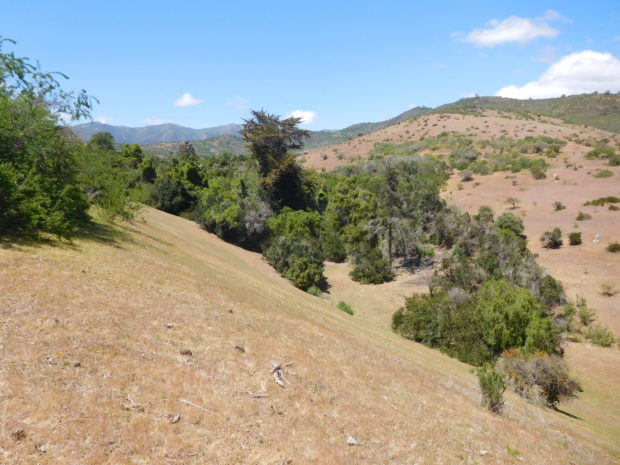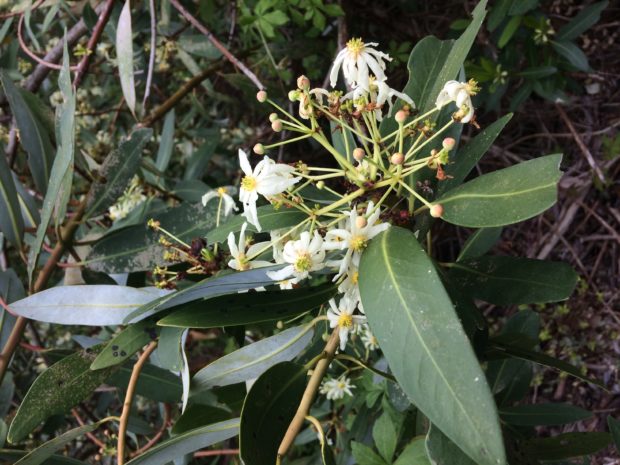
Marshy forests of the region that suffer the same drying conditions of the Ñague forest. Image: Antonio Maldonado.
By Medely Cortés
The so-called “Norte Chico” (Small North) of Chile has a semi-arid climate. Yet shrubs and bushes are common and, there are places where the flora is abundant and that trees seem out of place.
But a short time ago, Chile´s Center for Advanced Studies in Arid Zones (CEAZA) received an alarm call: the Ñague forest was drying up.
Yes, there is a forest in the city of Los Vilos, south of the region of Coquimbo. Its existence dates back thousands of years and has remained firm despite climatic fluctuations.
But lately it has languished.
The region´s swamp forests are exceptional and can be found in the north-central coastline of Chile. The Ñague forest is in private hands within the area of Agua Amarilla. It is owned by Patricia Matte, a member of one of the six wealthiest families in Chile, according to the Center for Economics and Business Studies at the Universidad del Desarrollo. There you can find cinnamon, myrtle and other plants that survive in what is typically a very humid environment.
But here, this type of vegetation survives because of what is known as microfrematic condition.

The region has different archaeological sites and has been investigated by multiple scientists. Image: Enrique Ostria
The swampy forest of the south coast of the Coquimbo region is fed by groundwater that runs through the porous sediment. This water flows not like a river, but moves much more slowly as filters under the ground. When the water approaches the soil surface, vegetation can grow and a marshy forest forms. That´s what happens in the Ñague ravine.
The Library of the National Congress of Chile characterizes the coast of the Coquimbo region as “abundant cloudiness; moderate temperature, with an average rainfall of 130 millimeters (5 inches) per year and a dry period of eight to nine months.”
In the past, the sector was characterized by its humidity, springs and mud. But now the soil is arid and the trees are drying up.
Antonio Maldonado, a paleoclimatologist at CEAZA, has observed the change in the forest for years. The problem is that “deep down the water table is lower because it has been recharged less,” Maldonado said.
But why?
Maldonado suggests two reasons and “probably a combination of both.” The first is related to the effects of climate change. Higher temperatures cause more evaporation. The second could be the artificial extraction of water that empties the soil layers. That water is used by farmers for irrigation, by miners who use water when drilling and by families for household use.
But the cause of the loss of water not yet clear, Maldonado said.
Water crisis in the region
Last May, Chile’s directorate general of water declared the Los Vilos community as an area of water scarcity. In 2017, Chile’s Ministry of the Environment also indicated that Los Vilos is at serious risk of desertification.
That agency noted an increasing number of heat waves in the region, information consistent with the latest report of the Intergovernmental Panel on Climate Change
“We are already living the consequences of a global warming of 1° C, with more extreme weather conditions, rising sea levels and a shrinking sea ice in the Arctic, among other changes,” Panmao Zhai, the co-chair of a working group of that international organization, said in a press release.
Use of underground layers
Climate change is a fact, so an important issue is how it affects groundwater.
Chile’s General Directorate of Water, is responsible for controlling how much water can be extracted from groundwater. There are no inspections in Los Vilos to check for unauthorized water extraction, according to that agency’s website.
But Miguel Pérez, a hydrogeologist at the Universidad Complutense de Madrid, says, “There are more wells not registered than legal.”
When water is for personal use, there is no need to register the water right of a catchment, unlike when the extraction is for commercial, agricultural and other purposes.
Government inspectors try to supervise water use. “What happens is that there are so many existing wells that inspectors that are contracted can-not cope and do not give so much control,” Perez said. “Then there are many (uses) that are illegal.”
The regulated water users must measure their annual and monthly extractions. But the uncontrolled wells can be emptying the aquifers.
Can the forest be saved?
“Naturally I think not,” Maldonado said.
But that depends on the cause of the water loss.
When it comes to climate change, not much can be done to intervene, he said.
“But it is also possible that the (water) layer is lower because every time more wells are made to draw water and that affects the forest,” he said. “There is something that can be done, but you have to convince the farmers to use less water, the miners to produce in a more sustainable way and thousands of things that obviously are not going to happen.”
Medely Cortés, a student at the University of Chile, participated recently in a Knight Center workshop for environmental journalists from Chile.
